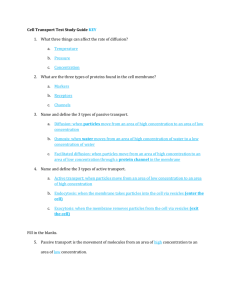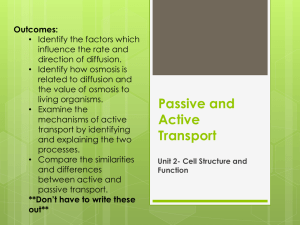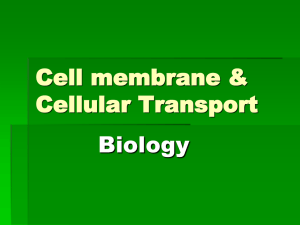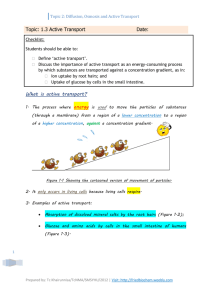Section 7.4- Cellular Transport
advertisement
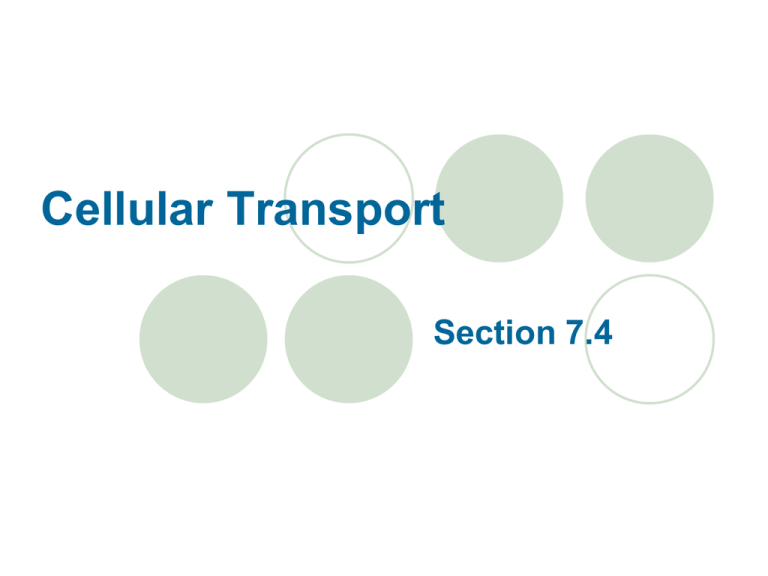
Cellular Transport Section 7.4 Cellular Transport How do substances move throughout the cell? Ever smelled cookies baking while you were in your bedroom? Two ways to transport substances: Without energy= Passive Transport With energy = Active Transport Diffusion is Passive Diffusion (AKA Passive Transport)- net mvmt of particles from an area where there are many to an area where there are fewer Animation The amount of substances in a given area is called concentration Substances diffuse from high to low concentrations Therefore, it doesn’t require energy! Fig. 7.20 What if the concentrations are the same? When there is continuous movement of the particles, but no overall change in concentration it is called Dynamic Equilibrium Three Main Factors of Diffusion 1. Concentration- high concentration, fast diffusion 2. Temperature- high temp, faster movement 3. Pressure- high pressure, particles are closer together and bounce into each other more often, faster diffusion CHEMISTRY!!! Diffusion Across the Plasma Membrane Besides diffusing water across the cell, other ions and small molecules get diffused, too Facilitated Diffusion- uses transport proteins to move other ions and small molecules across the plasma membrane Types of Transport Proteins Used in Diffusion 1. Channel proteins open and close the P.M. to allow the substance to diffuse that are polar 2. Carrier Proteins change shape as they diffuse to help move substances through the membrane Fig. 7.21 Passive Transport Reading Check- How do Na ions get into a cell? Applications of Diffusion Kidney dialysis Question: Do substances need a stimulus to diffuse across a membrane? Osmosis- Water’ You Doing? Diffusion of Water Water passes freely through the P.M. and doesn’t need transport proteins The diffusion of water is called osmosis Regulating water in the cell helps maintain homeostasis How it works: Solute/solvent – which is which? Solute is the thing being dissolved, solvent does the dissolving Water is the solvent If there is a lot of water, the concentration of the cell is low – it’s dilute Fig. 7.22 Reading Check- Compare and contrast osmosis and diffusion Types of Solutions- Egg Demo 1. Isotonic: Same concentration of water and solutes as its cytoplasm -Cells maintain normal shape Fig. 7.23 2. Hypotonic: if cell is in a solution that has a lower concentration of solute More water outside of cell than inside, so the water flows in because of osmosis and the cell swells Too much swelling can lead to a burst! Because plants of rigid cell walls, they don’t burst in hypotonic solutions Grocers use this idea to keep veggies fresh by misting them That’s how pickles are made Fig. 7.24 3. Hypertonic: the concentration of the solute outside of the cell is higher than inside Cells shrivel because the water is leaving the cell (less pressure) In plants, it causes wilting Fig. 7.25 Evaluate the benefits of sports drinks that contain electrolytes that athletes drink instead of water Is there any danger in consuming these drinks? Osmosis Active Transport What if a substance has to move from an area of lower concentration to an area of higher? It requires energy and is called active transport Occurs in pumps- carrier proteins that help in transport Carrier Proteins Active Transport Fig. 7.26 Why does active transport require energy? Na+/K+ ATPase Pump- A type of Carrier Protein Found in PM of animal cells Maintains the level of sodium ions (Na+) and potassium ions (K+) inside and outside of the cell What is it used for? This protein pump is an enzyme to help with energy storing molecules What’s it transport? Three Na+ out of the cell, 2 K+ into the cell Why? The cell needs to get rid of Na+ and needs more K+ But, since there’s lots of Na+ already on the outside of the cell and lots of K+ already on the inside of the cell, active transport has to be used Na+/K+ ATPase Pump Three Na+ bind to the transport protein to move out of the cell The transport protein requires ATP to change the shape of the protein After the protein changes shape, it releases the Na+ to the outside of cell In turn, the K+ on the outside of the cell bind to the protein The protein changes shape and releases the K+ on the inside of the cell Transporting Large Particles Sometimes diffusion or transport proteins don’t get the job done because the particles are too large Endocytosis is the process in which a cell surrounds the substance outside of the cell and engulfs it in the plasma membrane The membrane then pinches off and leaves the substance inside the cell Endocytosis Movie Transporting Large Particles Exocytosis is the opposite of endocytosis Cells use it to expel wastes and secrete cell products, like hormones, that were manufactured inside the cell Both Endo and Exo require energy to maintain homeostasis in the cell Movie Visualize It! Look at figure 7.29 Make a Venn Diagram to compare and contrast the processes of endocytosis and exocytosis. Questions to Ponder In what ways can materials move across a cell membrane? What is the difference between osmosis, diffusion and facilitated diffusion? Why are channel proteins needed? How do materials move against the concentration gradient? Pg. 208- Cutting Edge Biology

